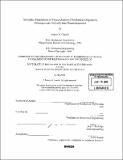Atomistic simulations of octacyclopentyl polyhedral oligomeric silsesquioxane polyethylene nanocomposites
Author(s)
Capaldi, Franco Mario, 1977-
DownloadFull printable version (9.072Mb)
Alternative title
Atomistic simulations of CpPOSS/PE nanocomposites
Other Contributors
Massachusetts Institute of Technology. Dept. of Mechanical Engineering.
Advisor
Mary C. Boyce.
Terms of use
Metadata
Show full item recordAbstract
As the scientific community develops the ability to create composites which incorporate nanoscopic filler particles, the detailed atomic arrangement and atomic interactions become significant in determining the composite properties. Nanoscopic fillers such as carbon nanotubes, polyhedral oligomeric silsesquioxane (POSS), and layered silicates have already been successfully used to improve the thermal and mechanical properties of polymers. On this length scale, details describing particle organization, interaction between particles, and interactions between particle and matrix are needed to understand the behavior of the composite. In this thesis, we use atomistic simulations to investigate the detailed behavior of a blended octacyclopentyl polyhedral oligomeric silsesquioxane (CpPOSS) / polyethylene (PE) nanocomposite. The model potential employed to describe the atomic interactions in these systems is capable of reproducing the experimental vibrational and crystal structures for the POSS well. The mechanical properties of an infinite crystal were calculated. The), are anisotropic with a Reuss average isotropic elastic modulus of 11.78 GPa. Simulations of CpPOSS/PE composites revealed that the POSS had a stiffening effect on the polymer. Simulations revealed that both PE and POSS dynamics as measured by translational and rotational diffusivities decreased, the glass transition temperature increased, and both the density and modulus increased with increasing POSS content. Micromechanical models were fit to the composite modulus which allowed effective mechanical particle sizes to be determined. (cont.) The POSS was found to aggregate into small necklace structures which have internal ordering similar to the crystal phase. The formation of crystallites was found to be energetically favorable in this system. A coarse grained potential which accounts for both the attraction and orientation between particles was developed to aid the further study of aggregation and crystallization in these composites. The interface between the POSS and the polymer is found to consist of polymer chains aligned tangentially to the POSS cage. This layer has increased mobility tangential to the surface of the particle and decreased mobility in the radial direction. Though it is very thin, consisting of only 1 or 2 monolayers of polymer, due to the small size of the POSS particle, the weight fraction of polymer in the interfacial region is as high as 43 % in the 25 weight percent CpPOSS/PE composite. These simulations reveal the formation of structure on both the angstrom length scale in the polymer near the interface and the mesoscopic length scale between the POSS particles.
Description
Thesis (Ph. D.)--Massachusetts Institute of Technology, Dept. of Mechanical Engineering, 2005. "June 2005." Includes bibliographical references.
Date issued
2005Department
Massachusetts Institute of Technology. Department of Mechanical EngineeringPublisher
Massachusetts Institute of Technology
Keywords
Mechanical Engineering.